Cardiff School of Art and Design staff are engaged in a range of internationally excellent and worldleading research, commercial activity, industry collaborations and community engagements. We regard Research, Enterprise and the cultivation of an exciting learning environment as integrated and mutually beneficial activities and we ensure that our students feel the benefit of the School’s research & enterprise excellence in the richness of the learning experience here and in the career prospects of our graduates.
LAUGH: Investigating the potential of handcraft and playfulness to support the wellbeing of people with dementia
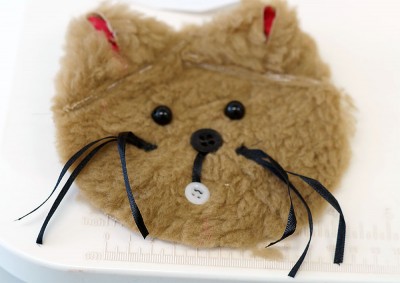
To engage, comfort and bring joy to people with dementia – that is the powerful subtext to Professor Cathy Treadaway’s investigation into Ludic Artifacts Using Gesture and Haptics (LAUGH). The three-year interdisciplinary research project, which is funded by the AHRC, launched officially in June with a fantastic two-day programme, including art and design workshops and insights from dementia organisations.
Led by Professor Treadaway, the project unites four other academic partners: Dr Gail Kenning (University of Technology Sydney Australia), Dr David Prytherch (Birmingham City University), Dr Andy Walters (PDR) and Dr Darren Walker (Cardiff School of Sport & Health Sciences). The research is supported by the Alzheimer’s Society and Age Cymru, and partnered by care home providers, Gwalia Cyf.
The team’s primary focus is on personalised playful devices – specifically those that incorporate embedded electronics and smart materials. The question: can these design solutions help to create more and more unique, meaningful moments for people with late-stage dementia? The hope is that, by offering some comfort and encouraging engagement, the devices will also distract from negative feelings and promote ‘in the moment’ living. Its relevance is not just personal to those with dementia; in a broader context, it relates to current calls from the World Health Organisation, and the G8 nations, for international collaboration to address the global challenge of the aging population.
Within CSAD, second year students will have the opportunity to learn some of the techniques developed by the LAUGH team in 2015-2016’s Interaction Design Field project and PhD student,Steve Coleman, will continue his work with Gwalia Cyf, which examines creative strategies to enhance the wellbeing of those living with dementia in long-term residential care.
Designs for Zambia: Working in collaboration with Cardiff University’s School of Medicine to develop design solutions for road traffic accidents in Chongwe, Zambia
Initially an undergraduate curious about culturally relevant design, Clara Watkins chose for her PhD to apply this focus to the Chongwe region of Zambia. Her objective – supported by Professor Judith Hall (OBE) from Cardiff University’s School of Medicine, Dr. Gareth Loudon and Professor Steve Gill from Cardiff School of Art and Design – was to develop a ‘trauma pack’ to tackle Zambia’s third biggest killer after HIV/AIDS and malaria: road traffic accidents. The research acknowledges that whilst populations of high-income countries benefit from advanced medical equipment, people in low-income countries often do not have access to the same life-saving resources.
At the heart of the research had to be the needs of the Chongwe region. Clara has spent much time there working with the community, volunteers, government officials and healthcare professionals. As a result, the team have successfully developed a design solution which is accessible, affordable, sustainable and, crucially, workable in situ; it not only has the potential to save lives but also to financially benefit local regions where it is manufactured.
For the next phase, Clara, now Research Officer, will strategise distribution, initially via a small social enterprise in Zambia. The team are also in early talks with international agencies to discuss the pack’s development into a disaster relief package for other countries. Clara will be bringing the medical contacts made during the project to an Innovation Day at CSAD in 2015-16. The aim is to create a series of ‘live’, ‘real world’ medical product briefs for Product Design’s undergraduate and masters students.
Fovography: A study of visual perception that combines ideas and research methods from art and science
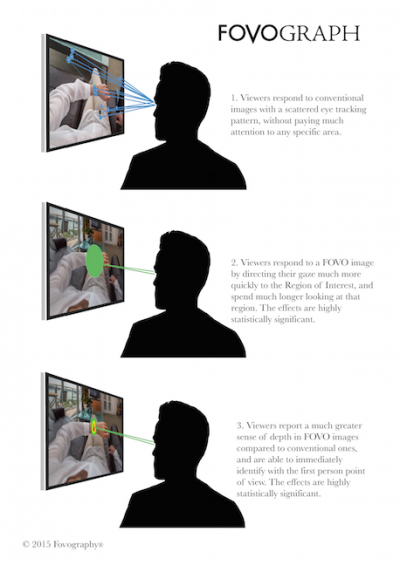
Conducting pioneering research into what we see of the world, the newly-established Fovolab has become a hub to explore the future of visual experience – and how artists might design with this knowledge in mind.
For students, it has proved an invaluable resource to gain some practical knowledge of how scientific insights can inform their artistic practice. Graphics, Illustration and Fine Art students, for example, enjoyed taking part in tests on the personal experience of visual space, which provided them with a richer understanding of their own perceptual processes; they reported such results as an increased awareness of their peripheral vision.
A number of Masters students have contributed by taking up the responsibility of becoming studio assistants. In these roles, many of the students have helped out with designing and constructing experimental apparatus, while others have assisted in workshops and participated in discussions about the philosophical implications of the Fovography research.
Led by Professor Robert Pepperell, the growing Fovography team, meanwhile, had two journal articles published in May; the first, As seen: Modern British painting and visual experience, published in Tate Papers, explores the surprising new ways that important British artists were painting features of visual experience in the twentieth century. The second, published by Frontiers in Human Neuroscience, investigates Artworks as dichotomous objects: implications for the scientific study of aesthetic experience. The team are currently looking at new forms of imaging and display media, which will in turn inform students interested in creating novel ways of presenting the final show degree work.
Perceptual Experience Laboratory (PEL): Simulating real world environments through the use of immersive sound, smell, temperature and vision
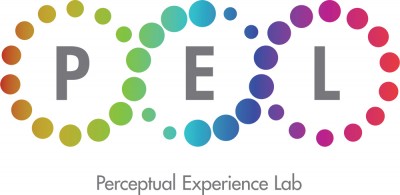
The newly installed Perception Experience Laboratory (PEL) – which uses Fovography™ enabled technology to simulate real world environments through the use of immersive sound, smell, temperature and vision – will enable Professors Robert Pepperell and Steve Gill, Dr. Gareth Loudon and Bethan Gordonto develop research and enterprise opportunities. This unique resource, which is available to CSAD students to use, has already attracted the commercial attention of major design consultancies and Jaguar Land Rover, and secured two interdisciplinary research projects.
The first, is entitled Thought for Food: A research-led approach to improved Welsh food industry
competitivenessand is a PhD study supported by Professor Steve Gill, Professor Robert Pepperell and Dr. Gareth Louden in association with Cardiff Met’s Food Industry Centre. It will assess whether data gathered in a simulated environment – in this instance, around food retail, branding and packaging – can reliably inform existing theories; plus whether these insights could be substantial enough to influence the trajectory of SMEs in the Welsh food industry.
The second sees the same team collaborating with Cardiff School of Management’s Tourism department and Cardiff School of Sport & Health Sciences on a project around workplace stress: why do so many employees fail to take the full leave they are entitled to? The study, led by Professor Annette Pritchard, with contributions from sport psychologists Dr. Stephen Mellalieu and Dr. Richard Neil, will utilise the PEL to identify links between stress and tourism experiences.
Making Innovations: Research and Enterprise by Artist Designer: Maker staff and students
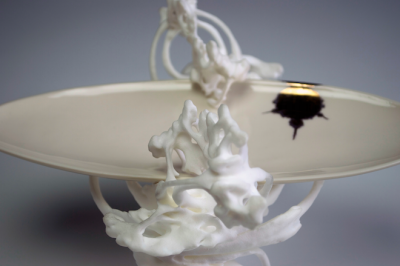
This year will see the first cohort of Artist Designer: Maker students graduate. Over the past three years, they have enjoyed creating across the artistic disciplines and even time itself; from age-old techniques, to cutting-edge technology and futuristic briefs.
Four of the graduating Artist: Designer Maker students are among this year’s new recruits at INC.Space, CSAD’s graduate incubation facility; figurative sculptural artist Alexana Blott; furniture maker Sarah Jenkins; decorative lighting designer Alice Elliott; and maker Sophie Adams, who will focus on limited edition books and book-binding.
Clearly embedded in the course’s ethos is the idea that student explorations can inform the practice of the teaching staff, and vice-versa. This was evident as ever at the Sensorial Object exhibition, which ran at Craft in the Bay from January through to March of this year. Featured as part of the exhibition was Ingrid Murphy and Jon Pigott’s interactive sound sculpture – The Campanologist’s Tea Cup – which has since been selected for the British Ceramics Biennial, taking place in Autumn 2015.
For third-year student Matthew Bush, the course’s emphasis on creating in the artistic space where old meets new provided the inspiration for his third-year project: a unique collection of elegant bowls made by fusing ceramic practice with 3D printing. He has since received sponsorship from Shapeways, a 3D printing service and marketplace, which will see his work feature on the company site.
Founder Ingrid Murphy has been awarded a National Teaching Fellowship, acknowledging the team’s efforts to facilitate a truly immersive learning environment.
Fine Art Research: Spanning the globe with CSAD’s Fine Art research
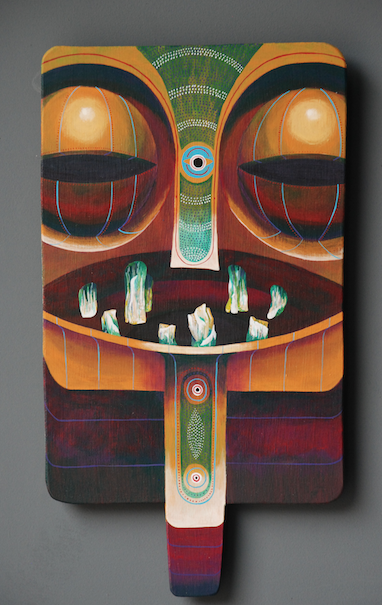
Recent highlights from the Fine Art department span a few thousand miles; in November, 19 Fine Art students travelled to Rome with David Fitzjohn and Dr. Jon Clarkson, where iconic sites such as the Vatican and the Caravaggio churches became the backdrop for a debate on continuity in art history, from the Renaissance period through to Modernism and Contemporary Art.
Sue Hunt travelled to Zambia to run educational workshops in conjunction with the Mothers for Africa charity. The Health Messages workshops and resulting exhibition provided an opportunity for health professionals at the newly renovated medical centre in the Chongwe region of Zambia to share important health information with the local community. The exhibition was also shown at the Butetown History and Art Gallery and workshops held at Rumney Primary School in Cardiff. Sue also took part in the Open Books: Artists and the Chinese Folding-Books exhibition and symposium held at the Chinese Univeristy of Hong Kong, presenting on the “Spirit of Collaboration”.
Over the Summer, Dr. James Green – sponsored by Santander – enjoyed a residency at the Universidadd of Santiago de Chile, where he was able to continue his research into mask-making. The experience has also been key in James’ development of a new Field project for 2015-16, entitled Magical objects: Masks and reliquaries of the world.
Closer to home, Professor Andre Stitt presented his ongoing work around performance art during ‘The Troubles’ at a new exhibition at the Golden Thread Gallery in Belfast; Collected histories: ‘Performance Art in Northern Ireland’. Running until September this year, Professor Stitt’s work features within the exhibition which, as a whole, focuses on performance art and its impact on conflict transformation in Northern Ireland during this period of civil conflict. In March 2015, Professor Stitt gave a keynote presentation on his research at the Live Art Development Agency in London; he has also contributed a book chapter on the same topic forPerformance Art in Ireland: A History, available now on Unbound at The Live Art Development Agency’s website.
Graphics in the Real World: Graphic Design staff and students responding to ‘real world’ briefs
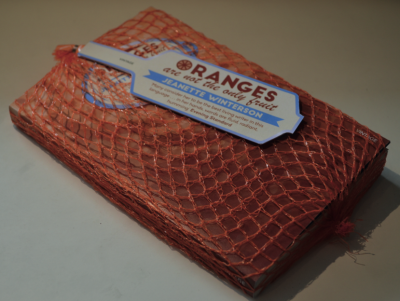
Fantastic ideas for sustainability campaigns emerged in the Real World Project, which partnered third-year students with industry mentors. The brief was to come up with a communication campaign around sustainability; a statement powerful enough to alter behaviours amongst the target audience of Cardiff Met students. The winning team’s campaign placed the issue of food waste where it couldn’t be missed by plotting a Farmers’ Market stall within student halls of residence.
Dr. Wendy Keay-Bright completed work on the Somability project with Rhondda Cynon Taf Skills for Independence, creating aerobic and therapeutic opportunities for people with disabilities through the development of a suite of motion-sensing software. As a result of this effort to provide for people who may otherwise struggle to find and partake in accessible sports and leisure activities, Dr. Keay-Bright was shortlisted as one of three finalists in the ‘Better outcomes through working together’ category at the 2015 Care Council for Wales Accolade Awards. In November 2015, she will travel to Melbourne, Australia, to present two workshops at the 50th anniversary conference of the Australasian Society for Intellectual Disability.
In the meantime, Dr. Keay-Bright has started on Somotopia, supported by the Raspberry Pi Foundation, which foregrounds participatory design methods to develop experimental interfaces using Raspberry Pi technology. A series of pilot workshops began in January 2015 in conjunction with ArtsDepot, inviting adults with learning difficulties to co-create performances featuring interactive digital arts.
International Greetings: Textiles students working with industry
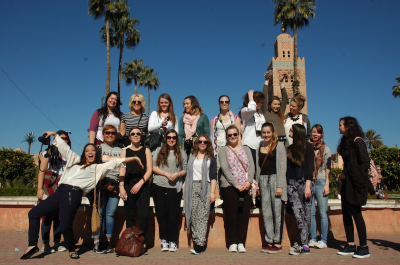
As part of a long-running relationship with Ystrad Mynach-based company International Greetings – one of the UK’s largest manufacturers of greetings cards and gift wraps – final-year students enjoyed a live brief to design their own range of products, from gift bags and bows, to ribbons and greetings cards. At an awards reception held at CSAD, Sarah Barker, International Greetings’ Head of Creative, selected four winners: Sarah Morris, Tiffany Gravenor, Ellie Jarvis and Lauren Bevan. Each received the top prize of £300, plus an eight-week work placement with the company, whilst seven runners up were awarded gift voucher prizes.
As part of the Field project, where the emphasis is on contextualising individual artistic practice in broader global and social terms, students this year travelled to Marrakech. The trip was led by Dr. Keireine Canavan, and based upon her research into traditional weaving techniques. A jam-packed itinerary allowed the students to immerse themselves in ancient and contemporary Arabic culture, through artisan workshops as well as through visits to Ancient Medina, 16th century Moorish museums, traditional architecture, formal gardens, and Berber campsites in the Atlas Mountains. They also enjoyed experiencing local cooking, crafts and belly dancing.
Exhibiting Ceramics: Staff and students engaging with exhibitions and ceramics in Wales and beyond
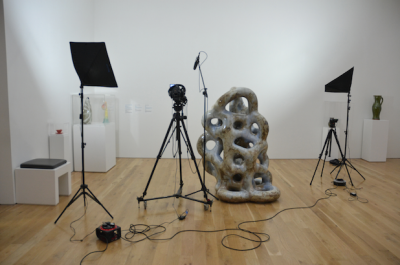
Lecturer Duncan Ayscough led March’s student trip to Jingdezhen, China, the country’s capital of ceramic production. The city is focused around ceramic production, from highly acclaimed artists to the largest industry producers, and home to the Jingdezhen Ceramic Institute. The purpose of the trip was to explore Jingdezhen’s creative legacy and its contemporary industrial and creative progression. The hugely positive experience gave students the opportunity to observe demonstrations of making techniques, such as throwing, glazing and firings, and incorporate these techniques into their own work.
Ayscough was also selected by the Mission Gallery, Swansea, to feature as March’s Maker in Focus, where his signature two-tone ceramic vessels – which juxtapose traditional exterior hues with vibrant, bold interiors – were celebrated.
Dr. Natasha Mayo and alumna Zoe Preece jointly curated the fantastic Sensorial Object exhibition, which ran from January to March at Craft in the Bay. Its purpose was to delve beyond the visual elements of objects; on opening night, guest speaker Dr. Zoe Laughlin posed the question, “which kind of metal makes the best-tasting cutlery?”
In April, the National Museum of Wales opened the doors to Fragile? – the country’s biggest contemporary ceramics collection. The exhibition features new works by four Wales-based artists, including Ceramics lecturer Claire Curneen and CSAD alumni Lowri Davies, Walter Keeler and Adam Buick.
For Dr. Mayo, collaborating with the museum has provided excellent grounds for further research into the exhibition as a site of debate. Working with CSAD graduate, Heloise Godfrey and INC. Space’s AJ Stockwell, Dr. Mayo is researching the dialogue between objects; specifically, ways to uncover previously silent encounters between them.
Students, too, have benefited from being given unprecedented access during the curation of Fragile?. The opportunity to discuss the exhibition with the museum’s designers, curators as well as the artists themselves enabled students to build upon their understanding of the curatorial process. Participation in the Work Experience Field project allowed a number of ceramic students to get involved as tour guides, running their own workshops and encouraging discussion among visitors to the exhibition.
Illustrating Experience: Illustrating the potential of drawing

An innovative research activity gave power to the humble doodle at last year’s Thinking with Jon Berger conference at Cardiff Met; attendees were encouraged to scribble and draw alongside their formal notes, with student ‘reporters’ gathering and relaying their images throughout the intervals. The collaborative project, devised by Chris Glynn and Dr Natasha Mayo, played into the conference’s broader discussion around the practice of drawing and its potential.
In May, students continued CSAD’s relationship with the Cardiff School of Medicine through their involvement with the Wales Millennium Centre/Clod Ensemble’s Performing Medicine season, devised to showcase the value of arts to the medical practice. The event was illustrated by students, with an exciting programme including a simulated demonstration of a medical emergency and a dancer’s interpretation of the human heart. CSAD lecturer Chris Glynn also took part in a panel discussion alongside Dr. Trevor Thompson and Dr. Catherine Lamont-Robinson of the Out of our heads project.
Meanwhile, lecturers Anna Bhushan and Amelia Johnstone continue their respective PhDs research exploring wellness and creativity. Anna is investigating mindful meditation and its relationship to creative ‘flow’. By contrast, Amelia is focused on the practice of drawing whilst running; she is currently working with MSc Product Design student, Gruffudd Hill, to redesign the scrolling mechanism of a machine specially developed to capture what is created, felt and remembered when drawing and physical activity are combined.
Designing for Industry: Applying Product Design research in industry contexts
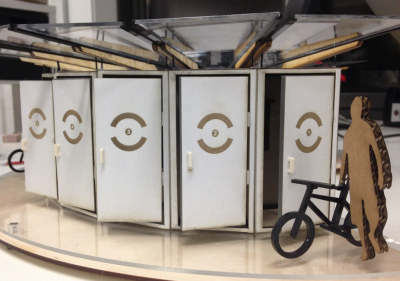
The year started with a real-world brief for Masters students to re-design bike storage for Odoni-Elwell, a company Product Design has previously worked with through Access to Masters and Knowledge Transfer Partnership (KTP) schemes. The KTP – run in collaboration with Odoni-Elwell and the EcoDesign Centre – came to a successful conclusion in July 2015.
For 2015-16, CSAD has been awarded a further KTP which will see Bethan Gordon, Head of Undergraduate Studies working with the Window Cleaning Warehouse, a company with which CSAD has an established relationship. Bethan’s efficient approach to design is underpinned by a high level of focus on user experience; she is currently completing PhD research entitled: Keeping it real – the potential for rapidly created simulated environments to mimic context of use scenarios in product user testing scenarios. As part of this ongoing research, Bethan has been collaborating with leading product design consultants (and ex Cardiff Met Product Design PhD students), Dr. Alex Wolley and Dr. Ian Culverhouse, as well as consultant anaesthetist at the University Hospital of Wales, Dr. Christian Diaz-Navarro.
Theo Humphries is also continuing with his PhD, asking What is the function of humour in Product Design, and for Product Design? whilst Gareth Barham has recently enrolled onto the PhD programme.
Meanwhile, Dr. Gareth Loudon has been supervising the second year of a Research Innovation Award-funded PhD with Dr. Nick Clifton (Cardiff School of Management). The purpose of the study is to investigate whether co-working spaces in South Wales can be developed to improve creativity and innovation in small companies.
R&E: From Rajasthan to Tiree: Students explore research and enterprise through CSAD’s Field Projects
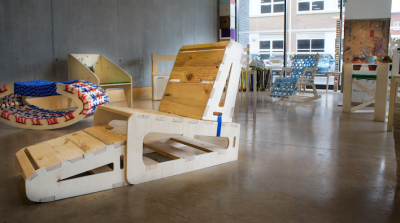
From CSAD workshops to study trips abroad, Field project options have continued to inspire students to think of their practice in broader social and economic contexts.
Richard Morris’ Enterprise projects Mind Your Own Business (equipping student teams with £100 to research, make and market their own product in just five weeks) and Are You Sitting Comfortably? (challenging students to design chairs for specific users) were big successes. In Painting Performance, students were hands-on in their efforts to fully understand the role of performance artists and their relationship to painting; they were briefed to enact versions of Yves Klein Anthropometrics, as well as the work of the Japanese Guitai group from the 1950s.
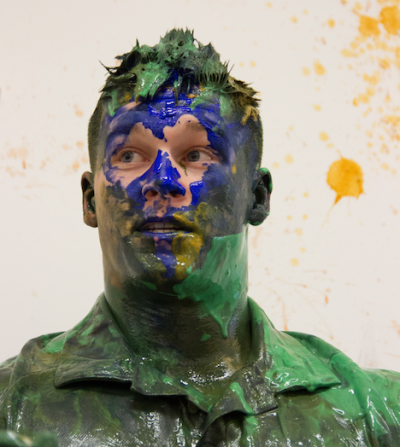
Meanwhile, in Art and the conscious mind, students practically engaged with historical and contemporary methods of representing the conscious state of vision. By focusing on different artistic methods – asking how and why they were developed – students supported their theoretical learnings which covered key topics of consciousness, self-awareness and the representation of reality, among others.
For many, the Field module was a jet-setting experience. During a two-week study trip to Rajasthan, Level 5 students were able to examine their practice in a vastly different culture. They enjoyed taking part in specialist workshops, visiting studios, and having the chance to collaborate with undergraduates from the Rajasthan School of Art.
A group of 15 Product Design staff and students also travelled to the Scottish Isles for the Tiree Tech Wave, a 4‐day research event organised by visiting Professor Alan Dix. Led by Professor Steve Gill, MSc students were challenged to use emerging multitouch technologies to design products to enhance the Tiree Rural Centre – the island’s meeting place and cinema – with the final designs including a pivoting mount for a projector. A group of MDes students visiting from Samsung Art and Design Institute (SADI) in Seoul, South Korea, collected data on the distinctive rowing boats that used to be made on the island, whilst the mobile
FabLab Cardiff ran workshops on everything from 3D scanning to laser cutting, delivered with the support of the Tiree Community Development Trust through the Tiree Windfall Fund and the MEET Lab project.
Theory into Practice: Combining research, theory and practice
CSAD's Constellation programmes combine theory and practice with the research specialisms of the School’s staff. One of many diverse highlights from 2014-15 saw Dr Jonathan Clarkson interviewed in The New York Times, where – on the strength of his monograph on Constable – he discussed the costly misattribution of the artist’s work at auction. In 2013, the painting (featuring Salisbury castle) was mistaken as having been produced by a Constable follower when it was listed and sold by Christies in London for £3,500. It was later identified as an original worth 1000 times as much.
Dr. Alexandros Kontogeorgakopoulos, meanwhile, continued research into haptic digital musical instruments. As part of collaboration with Cardiff University, he is working to replicate a traditional Turkish instrument (the ney) for the modern era. The God Article project, led by ethnomusicologist Dr. John Morgan (Cardiff University), proposed to add breath sensors to the replicas in order to facilitate online learning. Dr. Kontogeorgakopoulos also investigated the development of an audiovisual art installation of controlled quantum dynamical systems to explore the inherent beauty of the quantum mechanics, in collaboration with Aberystwyth University.
How to make (almost) anything: Using the global Fab Lab network and CSAD’s research and technical expertise to create an experimental workshop for Wales and beyond

FabLab Cardiff enjoyed a successful first season. The A4B funded MEET Lab project – a collaboration with PDR and Cardiff University’s School of Engineering – provided a range of workshops on emerging technology to local SMEs and produced a range of policy recommendations for the Welsh Government’s digital manufacturing support strategy. FabLab Cardiff has now received Cardiff Met Accelerator funding to develop a series of workshops for staff at secondary schools’ art & design and technology departments.
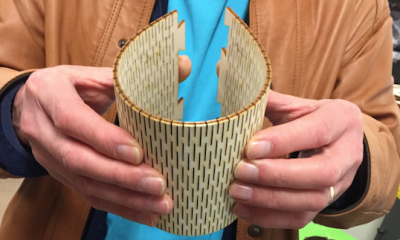
Continuing with its vision to enable businesses and ordinary people to make “just about anything”, FabLab Cardiff has delivered projects for CSAD and Cardiff Met students, with recent Cardiff Open workshops offering experience in everything from 3D printing to vinyl cutting.
FabLab Cardiff also now features in CSAD’s Level 5 Field projects, with a ten-week course fittingly entitled Fab-Field: How to make almost anything. Open to all disciplines, the Field project is designed to be a journey through the FabLab culture. It combines lectures on different applications in making with innovative briefs, as well as presentations and demonstrations on a range of skills and techniques. It also capitalises on FabLab’s global network, with students in communication with others around the world and participating in common online lectures. By the end of the ten weeks, students will come away with a portfolio of short projects made using digital fabrication and physical computing, as well as a major project. Previous ideas that have taken flight in FabLab Cardiff include everything from working product prototypes to interactive art installations; from furniture, to smart textiles; and from kinetic sculptures to interactive musical instruments.
Ecological Built Environments: Combining research to improve the sustainability of buildings in Wales
Ecological Built Environment Research & Enterprise (EBERE) combines interests in building performance, user behaviour and comfort in dwellings, natural building materials and heritage buildings.
Earlier this year, John Counsell was part of an international consortium organising workshops on the latest trends in architectural heritage and conservation, sustainability and Building Information Modelling. The event highlighted how heritage buildings are under increasing threat from unsympathetic redevelopment, inappropriate restoration and climate change. It also provides a new network in which John can progress with his research, which utilises 3D laser scanning to map heritage buildings and investigate the impact of climate change on their use and construction fabric.
Dr. John Littlewood has continued to work with Coastal Housing Group – a not-for-profit housing association operating in Swansea, Neath Port Talbot, and Carmarthenshire – on building performance and sustainability. Dr Littlewood has also continued his association with the Sustainability and Energy in Buildings (SEB) International Conference, and chaired the Conference’s Sustainable Buildings track.
This autumn, Nick Evans and Tony Wyman join Dr. Littlewood to support a short Knowledge Transfer Partnership (KTP) with Morganstone, a building contractor developing communities for housing associations and buildings for public sector bodies, local authorities and private developers. The exchange will place a KTP associate in the company; their aim being to introduce a thermal modelling and in-construction testing process to improve energy performance, increase occupant comfort and reduce maintenance costs.
